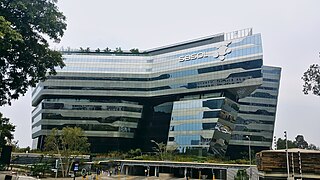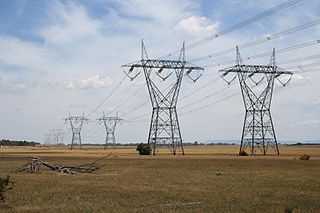Related Research Articles

Renewable energy is energy from renewable natural resources that are replenished on a human timescale. Using renewable energy technologies helps with climate change mitigation, energy security, and also has some economic benefits. Commonly used renewable energy types include solar energy, wind power, hydropower, bioenergy and geothermal power. Renewable energy installations can be large or small. They are suited for urban as well as rural areas. Renewable energy is often deployed together with further electrification. This has several benefits: electricity can move heat and vehicles efficiently, and is clean at the point of consumption. Variable renewable energy sources are those that have a fluctuating nature, such as wind power and solar power. In contrast, controllable renewable energy sources include dammed hydroelectricity, bioenergy, or geothermal power.

Lignite, often referred to as brown coal, is a soft, brown, combustible sedimentary rock formed from naturally compressed peat. It has a carbon content around 25–35% and is considered the lowest rank of coal due to its relatively low heat content. When removed from the ground, it contains a very high amount of moisture, which partially explains its low carbon content. Lignite is mined all around the world and is used almost exclusively as a fuel for steam-electric power generation.
The Fischer–Tropsch process (FT) is a collection of chemical reactions that converts a mixture of carbon monoxide and hydrogen, known as syngas, into liquid hydrocarbons. These reactions occur in the presence of metal catalysts, typically at temperatures of 150–300 °C (302–572 °F) and pressures of one to several tens of atmospheres. The Fischer–Tropsch process is an important reaction in both coal liquefaction and gas to liquids technology for producing liquid hydrocarbons.

Sasol Limited is an integrated energy and chemical company based in Sandton, South Africa. The company was formed in 1950 in Sasolburg, South Africa, and built on processes that German chemists and engineers first developed in the early 1900s. Today, Sasol develops and commercializes technologies, including synthetic fuel technologies, and produces different liquid fuels, chemicals, coal tar, and electricity.

Gas to liquids (GTL) is a refinery process to convert natural gas or other gaseous hydrocarbons into longer-chain hydrocarbons, such as gasoline or diesel fuel. Methane-rich gases are converted into liquid synthetic fuels. Two general strategies exist: (i) direct partial combustion of methane to methanol and (ii) Fischer–Tropsch-like processes that convert carbon monoxide and hydrogen into hydrocarbons. Strategy ii is followed by diverse methods to convert the hydrogen-carbon monoxide mixtures to liquids. Direct partial combustion has been demonstrated in nature but not replicated commercially. Technologies reliant on partial combustion have been commercialized mainly in regions where natural gas is inexpensive.
Syntroleum Corporation was a United States company engaged in development and commercialization of proprietary gas to liquids (GTL) and coal to liquids (CTL) processes known jointly as the Syntroleum Process. Renewable Energy Group acquired the company on June 3, 2014.
Underground coal gasification (UCG) is an industrial process which converts coal into product gas. UCG is an in-situ gasification process, carried out in non-mined coal seams using injection of oxidants and steam. The product gas is brought to the surface through production wells drilled from the surface.

The energy policy of Australia is subject to the regulatory and fiscal influence of all three levels of government in Australia, although only the State and Federal levels determine policy for primary industries such as coal. Federal policies for energy in Australia continue to support the coal mining and natural gas industries through subsidies for fossil fuel use and production. Australia is the 10th most coal-dependent country in the world. Coal and natural gas, along with oil-based products, are currently the primary sources of Australian energy usage and the coal industry produces over 30% of Australia's total greenhouse gas emissions. In 2018 Australia was the 8th highest emitter of greenhouse gases per capita in the world.

The Kogan Creek Power Station is a 750 megawatt coal fired power station owned by CS Energy on the Darling Downs in Queensland. The $1.2 billion plant is situated at Brigalow, in the Surat Basin between Dalby and Chinchilla.

Energy in Victoria, Australia is generated using a number of fuels or technologies, including coal, natural gas and renewable energy sources. Brown coal, historically, was the main primary energy source for the generation of electricity in the state, accounting for about 85% of electricity generation in 2008. The amount of coal-fired power has decreased significantly with the closure in 2017 of the Hazelwood power station which supplied around 20% of Victoria's electricity, and to a lesser extent with the exit of Anglesea power station in 2015. Brown coal is one of the largest contributors to Australia's total domestic greenhouse gas emissions and a source of controversy for the country. Australia is one of the highest polluters of greenhouse gas per capita in the world.

Queensland's energy policy is based on the year 2000 document called the Queensland Energy Policy: A Cleaner Energy Strategy. The Queensland Government assists energy development through the Department of Energy and Water Supply. The state is noted for its significant contribution to coal mining in Australia. The primary fuel for electricity generation in the state is coal with coal seam gas becoming a significant fuel source. Queensland has 98% of Australia's reserves of coal seam gas. An expansion of energy-intensive industries such as mining, economic growth and population growth have created increased demand for energy in Queensland.

The prospect of nuclear power in Australia has been a topic of public debate since the 1950s. Australia has one nuclear plant in Lucas Heights, Sydney, but it is not used to produce nuclear power. It is used to produce medical radioisotopes.It also produces material or carries out analyses for the mining industry, for forensic purposes and for research. Australia hosts 33% of the world's uranium deposits and is the world's third largest producer of uranium after Kazakhstan and Canada.

CS Energy is an Australia-based electricity generating company fully owned by the Government of Queensland with its head office located in Fortitude Valley, Brisbane. The company was established in 1997 and employs more than 500 staff. Adam Aspinall is the Board Chair and Darren Busine is the Chief Executive Officer.

An aviation biofuel is a biofuel used to power aircraft and is a sustainable aviation fuel (SAF). The International Air Transport Association (IATA) considers it a key element in reducing the environmental impact of aviation. Aviation biofuel is used to decarbonize medium and long-haul air travel. These types of travel generate the most emissions, and could extend the life of older aircraft types by lowering their carbon footprint. Synthetic paraffinic kerosene (SPK) refers to any non-petroleum-based fuel designed to replace kerosene jet fuel, which is often, but not always, made from biomass.

The natural gas in Qatar covers a large portion of the world supply of natural gas. According to the Oil & Gas Journal, as of January 1, 2011, reserves of natural gas in Qatar were measured at approximately 896 trillion cubic feet ; this measurement means that the state contains 14% of all known natural-gas reserves, as the world's third-largest reserves, behind Russia and Iran. The majority of Qatar's natural gas is located in the massive offshore North Field, which spans an area roughly equivalent to Qatar itself. A part of the world's largest non-associated, natural-gas field, the North Field, is a geological extension of Iran's South Pars / North Dome Gas-Condensate field, which holds an additional 450 trillion cubic feet of recoverable natural-gas reserves.
The Australian Energy Market Operator (AEMO) performs an array of gas and electricity market, operational, development and planning functions. It manages the National Electricity Market (NEM), the Wholesale Electricity Market (WA) (WEM) and the Victorian gas transmission network. AEMO also facilitates electricity and gas full retail contestability, overseeing these retail markets in eastern and southern Australia. It is additionally responsible for national transmission planning for electricity and the establishment of a Short Term Trading Market (STTM) for gas.

Linc Energy was an Australian energy company that specialised in coal-based synthetic fuel production, as well as conventional oil and gas production. It was engaged in development and commercialisation of proprietary underground coal gasification technology. Produced gas was used for production of synthetic fuel through gas-to-liquid technology, and was also used for power generation. The company had its headquarters in Brisbane, Queensland.
AFC Energy PLC is a developer of hydrogen fuel cell technologies which focus on the displacement of diesel generators in stationary and maritime applications. The technology utilises hydrogen fuel for zero emission electricity generation. The company is based in Cranleigh, Surrey, United Kingdom. It is listed on the London Stock Exchange.

Hi-Gen Power was a London-based developer of projects combining underground coal gasification with carbon capture and storage and alkaline fuel cells. It was established in 2009 to commercialize alkaline fuel cells developed by the fuel cell manufacturer AFC Energy. It is affiliated with B9 Gas.
UCL Australia was an international campus of the University College London, located on Victoria Square in Adelaide, South Australia. It had three parts: the School of Energy and Resources (SERAus), the International Energy Policy Institute (IEPI) and a branch of UCL's Mullard Space Science Laboratory. UCL Australia described its university community as "welcoming, dynamic and influential." The campus closed in December 2017.
References
- ↑ "Infinite Power Company Limited, Company number 11325982". Companies House. Retrieved 29 November 2021.
- ↑ "Who's Who" . Retrieved 25 November 2021.
- 1 2 3 Hutchens, Gareth (9 July 2011). "Enough drive to shape Australia's future". Sydney Morning Herald. Retrieved 22 November 2021.
- ↑ Heathcote, Andrew (27 May 2012). "Could you be next?". Sydney Morning Herald . Retrieved 29 November 2021.
- ↑ "Linc Energy CEO and Dunk Island owner Peter Bond challenges tourism officials to sell the Sunshine State better". Sunday Mail . News Corp. 12 September 214. Retrieved 29 November 2021.
- ↑ "The man behind Linc Energy's comeback". CNBC. 22 August 2014. Retrieved 6 December 2021.
- ↑ "Linc pilot flows first GTL fuel" . Upstream Online . NHST Media Group. 14 October 2008. Retrieved 6 August 2009.
- ↑ "Taking a ride on a coal-fuelled plane". Brisbane Times. Fairfax. 8 May 2012. Retrieved 29 November 2021.
- ↑ "Abramovich's Investment Vehicle Scores Clean Energy Deal". Wall Street Journal . 20 June 2013. Retrieved 29 November 2021.
- ↑ "Eat Like a Billionaire". Fox News. 31 December 2012. Retrieved 29 November 2021.
- ↑ "'Seven-year witch hunt': Linc Energy case sensationally dropped". The Courier-Mail . 17 August 2021.
- ↑ "Queensland islands take a big hit from Cyclone Debbie". The Australian . 15 April 2017. Retrieved 29 November 2021.
- ↑ "Homepage". Infinite Power.
- ↑ "Clive Palmer snaps up Peter Bond's Brisbane trophy home for a bargain price". www.realestate.com.au. Retrieved 22 November 2021.
- ↑ "Ten Questions: Peter Bond". The Australian. News Ltd. 25 April 2011. Retrieved 29 November 2021.
- ↑ "TV bid by giving mining magnate Peter Bond". Perth Now. The West Australian. 19 April 2011. Retrieved 29 November 2021.
- ↑ "Where it All Began". roughdiamondmedia.com. 29 November 2021. Archived from the original on 21 February 2020.